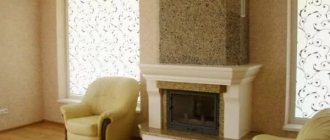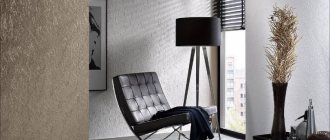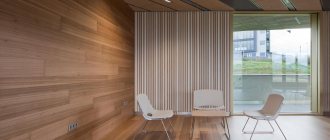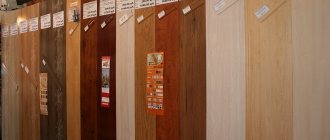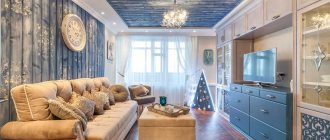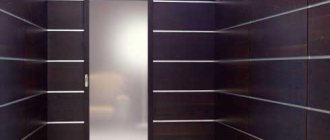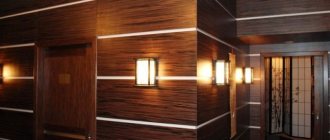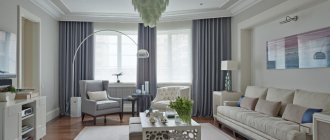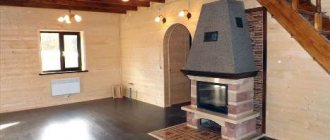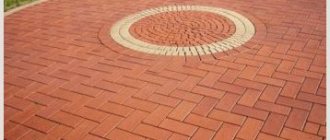Types of MDF panels by production technology
The following modifications are distinguished, depending on the production technology used:
- Standard. The simplest option, low cost, as it does not have any additional features. It is used for finishing strictly in rooms without sudden temperature changes.
- Moisture resistant. Treated with a special compound that can withstand moisture. It can be used in bathrooms and toilets, but prolonged and direct exposure to water will still damage the panel.
Panel types
In turn, special panels are divided into several types:
Moisture resistant. They can be used in rooms with high humidity.
Heat resistant. The composition uses fire-resistant impregnations that prevent the material from igniting in a fire. When heated, they smolder, releasing high levels of chemical compounds.
Flexible. They are used to create arched structures. These products are distinguished by their ductility and durability during operation.
High density products. They are designed for the manufacture of structures with increased load.
Types of panels according to the method of design of the front part
The front part of MDF panels can be divided to a large extent, which creates a wealth of choice:
- Laminated. Resistant to many factors: moisture, mechanical damage, etc. It is obtained by applying a special layer to the surface of the panel.
- Veneered. A thin layer of wood is placed on the surface, which gives the product a beautiful structure.
- Cork. A special production technology allows the wall panel to be covered with a thin layer of cork. The resulting modification is very expensive and does not always justify its use.
- decorative Imitating natural stone, brick or tile.
Options for interior design of rooms with MDF panels
MDF panels can be used in almost all rooms and can be used in almost any interior style. This finishing material can be laid on the wall in different ways:
- From below - thanks to this installation you can visually increase the height of the ceilings. In addition, with the help of this option, designers achieve expansion of the room area due to the same visual effects. This option is well suited for the kitchen, corridor or hallway;
Thanks to this installation, you can visually increase the height of the ceilings. - Over the entire wall area - this method makes the room laconic, cozy and stylish. Most often, all walls in a home library, office or living room are covered with panels;
This method makes the room laconic, cozy and stylish. - As a decorative element, MDF boards are used in all rooms except the bathroom. For example, designers often cover one wall with panels, placing emphasis on it. All the rest are covered with another finishing material. This method is typical for the living room, bedroom, kitchen and dining room.
Designers often cover one wall with panels, placing emphasis on it.
MDF boards are often used in the kitchen as an apron. In this case, moisture-resistant products with a high degree of resistance to external influences are selected. They also line the wall in the living room and mount a TV on it or make an imitation of a fireplace below. In the bedroom, MDF panels line the wall near which the bed stands.
In fact, there are a huge number of options for finishing wall panels made of wood-based material. You just need to not be afraid to experiment and create your own unique style.
Advantages and disadvantages
Before choosing any building material, you need to familiarize yourself with its advantages and disadvantages.
Advantages of MDF panels
- Availability. Easily found at most hardware stores or specialty markets.
- Low cost. The total cost of the purchased material will be less than most analogues.
- Ease of installation. The simplicity of the design allows you to install MDF panels quickly and without problems. Even a person with no experience can do this job if they have the necessary tools.
- Presentable appearance. The appearance of MDF panels looks extremely solid, especially the colors that match expensive wood species.
- Additional thermal insulation and sound insulation.
- Safe composition. Do not contain substances harmful to human health.
Flaws
- Fire hazardous. Made from wood components, the panels can catch fire when exposed to flame.
- Poor moisture resistance. A damp indoor environment is not the best option for placing MDF panels. Long-term exposure to a humid environment negatively affects the structure of the material, it swells and bends.
Advantages and disadvantages of using MDF panels for walls
When choosing a finishing material for walls, the owner of a house or apartment should know everything about the strengths and weaknesses of this material. MDF panels are no exception here. Below are their advantages:
- Wall panels made from wood chips have a low cost, so they are always available on the construction market;
- MDF panels are easy to install. To install them on the wall, you do not need to invite a master finisher. You can do everything yourself if you follow the instructions;
- Fastening the plates does not take much time;
- This facing material quite realistically imitates real wood. It looks laconic in the interior and makes the room cozy;
- Wall panels can be used as heat and sound insulation products. Insulation is simply inserted into the space between the frame and the slabs. You can also hide communications using lathing and slabs.
This facing material quite realistically imitates real wood.
MDF boards for walls also have some disadvantages. Among them are especially distinguished:
- Sometimes such slabs are very easy to deform;
- If the panels are attached to the sheathing, the area in the room is visually reduced;
- Fiberboard is susceptible to combustion. Of course, there are products coated with fire-resistant mortar. But they cost much more;
- This finishing material may lose its appearance from exposure to moisture, steam and temperature changes. Therefore, it cannot be used in the bathroom, swimming pool, on the balcony and loggia, as well as in the sauna and bathhouse.
This finishing material may lose its appearance from exposure to moisture, steam and temperature changes.
Types of wall panels
The variety of types is another plus for the MDF panel. The interior can be recreated to suit every taste thanks to its diversity. Several types of panels are most often included in the interior, which are really successfully used in the design of apartments and houses:
- Laminated panel.
The thin film makes the panel functional and gives it a slight shine rather than gloss. The wall in the living room, kitchen, bedroom will only benefit from using the panel in the interior.
- The moisture-resistant panel is made from natural high-quality wood and is repeatedly impregnated with water-repellent ingredients. This panel can be used for the design of a bathroom, loggia, and open terraces. A movable wall in the shower can also be mounted from this material.
- A veneer panel is an ideal option for decorating a bedroom, living room, or creating light partitions. A sliding wall combined with glass is an excellent option for small apartments. During its production, a thin wooden veneer - a cut of natural solid wood - is attached to the main glued solid wood. Its front side has a textured wooden individual design.
- Glossy panel. The surface is laminated with a transparent, durable film and has a perfect glossy shine. This panel will easily fit into the interior of a bathroom or hallway. In the photo, the options for finishing with glossy MDF panels perfectly convey its structure.
- Painted panel. This option, in both matte and glossy formats, will allow you to add the desired color scheme to your interior.
- Panels with 3D effect. This is truly a great chance to create a completely individual wall design, to realize even the wildest wishes for your home.
According to their shape, the panels are:
In the form of slats (narrow panels) having a groove connection: groove - ridge. They are easy to install independently and are widely used for cladding.
Narrow panels with a groove connection
In the form of sheets of various sizes. The sufficient area of the sheet allows you to use different techniques for its design: photo printing. 3D images, panels and graphics.
Sheets of panels of various sizes
In the form of slabs, similar to large tiles. To fasten the design of these products, just like slatted panels, a “groove-tongue” locking connection is provided.
Slabs similar to ceramic tiles
Based on their appearance they are produced:
With a veneered surface, when the top layer consists of a thin coating of natural wood, which is called veneer. The product looks completely identical to a natural wooden board and is significantly less expensive.
A variety of decorative wall panels with photos
The panels vary in shape, have characteristic properties, are used in a particular room, and perform certain functions. The forms are divided into three groups.
- Slatted panels are long planks, for the production of which PVC, fiberboard, chipboard, and MDF are used. They are often mounted in rooms with many corners, in small rooms. Light panels can visually adjust the space of a small room (kitchen, bathroom, hallway, balcony). The horizontal arrangement of the planks will elongate the walls, and the vertical arrangement will visually raise the ceiling of the room. Wall panels of this shape are easy to install; they are attached with staples or screws to aluminum or wooden sheathing.
- Tile panels are square in shape from 30 cm to 1 m. They are fastened using steel plates for fastening or glue. If you arrange wall panels on a plane in different ways, you will get interesting options for wall decoration. By arranging the slabs at different angles and at several levels, you can get an original design for the interior of the room. The final touch will be the built-in lighting between the levels.
- Sheet wall panels are the largest in size (1.22 by 2.44 m, thickness - 3 cm), most often made of PVC and fiberboard. They form a multi-level structure with an applied pattern, texture that imitates other finishing materials (wood, stone, brick) or a combination thereof. The panels are attached with glue, and the seams formed between them are filled with moldings.
| Kinds | Material | Advantages | Flaws |
| Wooden panels | Oak, cedar, maple, alder, walnut, pine | Eco-friendly material; Improves the interior; Combines with other facing materials | They do not tolerate moisture; High price |
| MDF - panels | Wood waste compressed under high temperature | They have sound and heat insulating properties; Can be made moisture-resistant, fire-resistant; Easy to care for | Not recommended for use in the kitchen or bathroom |
| Fiberboard - panels | Wood fibers compressed at a temperature of 180-200 C | Wide range of colors and textures | Low moisture resistance |
| Chipboard - panels | Sawdust and shavings impregnated with formaldehyde resins | Big choice panels covered with veneer, plastic | Harmful to humans and the environment; Cannot tolerate high humidity; Difficulties during installation |
| Bamboo panels | Bamboo tess | Easy to install; Withstands changes in humidity; Vapor permeable; Universal; Acceptable price | Cannot withstand severe mechanical damage |
| Gypsum vinyl panels | Vinyl coated drywall | Strong, durable; Combines with other finishing materials | Insufficiently moisture resistant; Not all products are suitable for cleaning |
| Glass panels | Strained glass | Resistant to external natural influences and moisture; Serve as a solid basis for creating drawings | Do not clean with products containing abrasives; Difficulty in cleaning the surface in the form of streaks and stains; Exposure to direct sunlight will damage the pattern on the panels over time |
| Stone veneer | cut stone | Environmentally friendly and safe material; Durable and reliable; Adapts to any surface shape | High price |
| Soft panels | Leather, textiles | Easy to care for; Resistance to moisture, sunlight and temperature changes; Soundproofing | Frequent cleaning required; For any damage, the entire panel is replaced |
The following types of panels deserve special attention. Some of them appeared relatively recently and differ from previous ones in their originality and creativity.
Modern room design with wall panel
Apartment interior with wall panel
Original room design using wall panels
Scope of application
MDF wall panels are very popular in modern design, and they are most often used for interior decoration. This material is considered ideal for preparing walls for decoration, since the surface of the sheets can be used as a basis for cladding. The products are characterized by high sound and heat insulation and have no external defects, so they can be chosen for decorating corridors and hallways.
Since MDF boards have a maximum thickness of 10 mm, their properties are in no way inferior to brickwork and concrete surfaces. In this regard, they are often used to level walls, combined with drywall.
Such panels are also a good finishing material for flooring. A floor made of MDF is equivalent to laminate. In addition, wall products can be found not only in the interior of residential premises, but also in offices, finishing columns and arches. Walls decorated with natural wood in shops, restaurants, cafes and hotels look original. Due to the fact that MDF panels come in different textures and colors, this allows them to be used in construction: to beautifully design platbands, cornices, and baseboards.
MDF panels have also found their use in kitchen decoration: they are used to decorate the work area and apron. This material is not afraid of high temperature and moisture, so you can easily use it to decorate the surface of walls anywhere and create an original interior.
Bedroom decoration
The walls of the bedroom, like those in the living room, are rarely lined with MDF. If you plan to use this material for wall cladding in this room, you should approach it with caution. Despite the safety of its modern manufacture, it is wiser to use soft, breathable wallpaper for a bedroom in an apartment. But for a private house or cottage, where the room is not heated in winter, it is quite suitable.
The best solution for MDF panels for a private home
MDF is not afraid of large temperature fluctuations and is not subject to deformation due to this. It is also better to cover the walls in the living room in fragments. The wall at the head of the bed is often decorated with this material.
Finishing material at the head of the bed
The cladding of the wall behind the berth with 3D panels with an imitation of carriage reupholstery looks interesting. This design looks especially modern.
Imitation of Capitone at the head of the bed
Using MDF panels to decorate the living room
All walls in the living room are rarely lined with MDF panel elements. An interior in which this material is used only in fragments will be attractive.
Wall cladding with light panels
For example, you can focus on one wall by covering it with 3D panels with a pattern that suits the style. The photo shows a design option for a living room, in which one wall is lined with 3D elements in the form of waves. This panel fits well into the overall interior of the living room.
3D waves in your living room
Designers often use panels to cover one wall to complement some piece of furniture, for example, finishing a wall on which a TV hangs.
The accent for the wall is a picture or TV
If you nevertheless decide to cover the walls in the living room completely with panels, carefully consider their location. The longitudinal arrangement is suitable for rooms with low ceilings. This visually increases the height of the room.
Longitudinal arrangement of panels for low ceilings
The transverse arrangement is suitable for large spaces.
The transverse arrangement of the panels is suitable for a large room
The use of MDF panels in the decoration of bathrooms and toilets
Modern MDF wall panels can be successfully used for finishing bathrooms and toilets. Nowadays many types of such products with moisture-resistant qualities are produced.
A beautiful and unusual solution for the bathroom
With their help, you can successfully imitate ceramic tiles without fear of destruction of the material from moisture. At the same time, it will cost much less than tiles. At the same time, the variety of design designs is much wider than ceramics. You can use panels with fragments of a painting applied to them to create a whole panel in the bathroom.
Panel made of MDF panels in the bathroom
By choosing the products in the form necessary to implement your intended style, you can decorate your bathroom in a completely original way.
Moisture-resistant panels for bathroom decoration
The bathroom is finished with panels coated with protective varnish in dark colors. With a white bathtub and sink, the walls look magical.
Dark room with white fixtures
By using a design in light colors, you can get a completely different look for your bathroom.
Light bathroom with black accents
Such walls will last quite a long time. They also wash well from dirt without losing color brightness. The only negative is that you cannot use aggressive cleaning agents to avoid scratching the protective surface.
Eco-friendly material for comfort
The protective and decorative layer of MDF must be protected from damage so as not to reduce the material’s resistance to moisture.
Decorating the hallway with MDF panels
Decorating a hallway is not as easy as it first seems. This is a problematic room because there is little light in it. It usually contains several doors, which create difficulties when installing panels. Here the walls are most exposed to contamination because the hallway is a common area and is not as large as the living room.
In the hallway the walls are more dirty
Taking these features into account, it is better to decorate the hallway with slatted panels. They are convenient for cladding a hallway, because they are small in size and can fit into any problem area.
The appearance of the surface of such products should correspond to the style of the hallway and its characteristics. For cladding a small hallway, light, monochromatic products are better suited; they will visually enlarge the room.
Slatted panels for a small hallway
It is successful to use vertically arranged panels of yellow and white colors, which alternate with each other. The doors are upholstered with brown slats to match the furniture elements located in the corridor.
Vertical MDF panels in two colors in the hallway
The walls in the hallway cannot be completely finished with panels. The corridor looks interesting, in which the walls are covered with MDF only on the bottom, and on top are covered with wallpaper that matches the tone.
This design can be used for a medium-sized hallway or in a large space.
What are MDF panels
MDF panels are a facing material that consists of sawdust and binders. The sawdust is heated and pressed under high pressure. The result is a particle board. In appearance, it resembles a solid piece of noble wood. However, its price is comparatively lower. MDF panels are also popularly called lining. After heat treatment, a melamine film is applied to the boards to imitate the porous structure of noble wood. You can give this finished material the desired shape and size using a regular jigsaw or hacksaw.
MDF panels are a facing material that consists of sawdust and binders.
What are the sizes of MDF panels?
Wall cladding with MDF panels is the best option for any room except the bathroom; this material is devoid of the cold and unnatural shine inherent in plastic, and a large selection of sizes and patterns will allow you to make beautiful and high-quality repairs even on a limited budget.
The size of the panels depends on the manufacturer, but before installation, the buyer needs to determine what kind of design he wants to get in the end:
- The standard length of an MDF panel is 2600 mm; a little less often you can find products with lengths of 2400 and 2700 mm. For installation, this does not matter at all, because, as a rule, sawing is carried out in the shop;
- The width of the panels is from 150 mm to 900 mm, less often you can find panels with a width of 1200 mm. It is this parameter that has a great influence on the final aesthetic effect, since the wider the panel, the brighter and more emphasized the texture, and the large number of vertical seams does not catch the eye;
- The thickness of the panel, depending on the manufacturer and the chosen model, can range from 3 mm to 30 mm, and if it is a panel with veneer, it can reach up to 60 mm. Thus, you can always choose the optimal panel option for any type of room - large or small.
- When choosing, you should keep in mind that the thinnest panels, which are also the most fragile, should essentially only perform a decorative function. Products from 12 or more millimeters, in addition to decoration, can also be used as good insulation, because in their thermal insulation properties they are comparable to brickwork, 15 cm thick.
How to attach MDF panels: lathing size and sheet installation
It is quite possible to install MDF wall panels yourself. For this purpose, it is enough to buy MDF panels for walls, the dimensions of which correspond to the requirements of the existing room, and also find some tools that everyone will probably have in their pantry.
Wall slabs in the bedroom are mounted using adhesive method
There are two possible methods of fastening: on an adhesive base or on a lathing. The second option is mainly used, since it is this that allows you to hide existing communications, and also not to worry about dismantling the previous coating. If glue is used, the prepared surface must be perfectly flat and smooth, which is not always possible.
To work, you will need a tape measure, a building level, a screwdriver, a metal corner, a handsaw or a jigsaw, as well as screws or glue, depending on which method you choose.
Fastening MDF panels using clamps
In order to evenly attach the panels with glue, you first need to apply the appropriate markings, starting from the corner of the room. The vertical and horizontal boundaries of each panel that will be fixed are indicated. After this, you can apply glue to the back of the panel as indicated on the packaging and glue the element to the wall. As a guide, it is recommended to look at photos of wall decoration with MDF panels.
The presence of special locking grooves guarantees reliable adhesion of the panels to each other
If you decide to do the sheathing, then you must adhere to the standard recommendations for this type of work:
- to create the sheathing, you can use both metal guides and simple wooden blocks;
- the distance between the sheathing elements should be 40-50 cm. This will ensure the most reliable fixation of the panels;
- It is necessary to strictly ensure that the sheathing is level. Otherwise, this may affect the cladding - it will be wavy;
- you need to start attaching the slabs from the corner of the room;
- it is necessary to check that at the joints the panels fit tightly to each other without forming gaps;
- it is necessary to leave some distance between the floor and the panels, which will subsequently cover the baseboard;
- in order to give the corners an aesthetic appearance, use a special flexible corner.
Scheme of installing panels on walls (left) and on ceilings (right)
Like any other renovation work, wall cladding with MDF panels requires effort and attention. However, this task can be done by almost anyone who has at least basic skills in working with tools. To make your task easier, you can use detailed videos or photo instructions, of which there are quite a lot on the Internet.
Regardless of the area of use, MDF wall panels for interior decoration demonstrate equally good performance. The main thing is to approach their choice responsibly, conduct a thorough inspection and make sure that the products comply with certification, are environmentally friendly and can serve you for a long time.
How to calculate the required number of PVC panels?
To calculate the number of PVC panels, you first need to know the perimeter of the base that you plan to cover. After this, the perimeter of all doors and windows should be subtracted from the obtained value, and then the difference should be divided by the perimeter of one element.
Don't forget that some of the material will have to be cut
As an example, we will give a situation where it is necessary to make the external decoration of the walls of a one-story house 6x8 m with a height of 2.5 m with PVC panels. The building has 4 windows and 1 door. The dimensions of one window are 1.8x1.2 m, and the doors are 2.2x0.9 m. In this case, plastic panels with dimensions of 250x30 cm will be used.
First of all, let's calculate the total area of the walls:
(6+6+8+8)*2.5 = 70 m2
Then you need to find out the area of all windows and doors:
1.8*1.2*4+2.2*0.9 = 8.64+1.98 = 10.62 m2
Subtracting the area of the walls from the area of windows and doors, we get the usable area, that is, the one that will need to be sheathed:
70-10.62 = 59.38 m2
After this, you should calculate the area of one panel:
2.5*0.3 = 0.75 m2
So for the example above you will need:
59.38/0.75 = 79.17 panels
Rounding this value up, we get 80 pcs.
Color spectrum
MDF panels come in a variety of colors, so choosing the right shade when decorating your walls will not be difficult. Before choosing the color and texture of this material, you need to take into account the overall palette of the room. Therefore, first the main background of the interior is determined, after which it can be supplemented with colored panels. As a rule, white, gray, olive and beige colors are recommended for decorating rooms. Slabs that imitate wood such as oak or wenge would also be an interesting design option.
Walls decorated with material in orange, red and yellow shades will visually expand the room and fill it not only with bright colors, but also with an unusual atmosphere. To decorate kitchens, it is recommended to choose green MDF, which helps relieve stress and has a positive effect on the nervous system.
In addition, blue and blue shades are also good for kitchens.
Products in pink and purple colors look special: a designed design in such a palette will acquire a certain mystery, but since such shades are bright, they cannot be used in large quantities. It is best to combine them with light colors. The most natural color is brown - it is most often used when decorating walls in the kitchen and hallway.
As for white, gray and black shades, they harmonize perfectly in any interior. To brighten up the solidity of a room whose walls are decorated with panels of this color, it is recommended to use bright inserts and original decorative items. In addition, many designers prefer to use beige MDF in the interior, since this shade simultaneously combines chic and restraint.
Colors of MDF panels: catalog of the most popular solutions for creating an interior
Technical characteristics and price of MDF wall panels do not always play a decisive role in the matter of choice. Often we focus on color, wanting to choose the most suitable option that will fit perfectly into the interior. In order to appreciate the diversity of the offered assortment, just look at the photo of the decoration of the hallway or any other room with MDF panels, which are offered on specialized resources.
On sale you can find both solid-color options and imitations of a wide variety of surfaces: MDF panels for brick, stone, exotic woods, white gloss MDF, and much more.
MDF panels can be painted in various colors
You can often see furniture made from this material. Most often on the Internet you can find photos of kitchens made of MDF. Both the prices and characteristics of such products are much nicer than those made from many other materials, and the design possibilities are almost limitless. This was the reason for their popularity.
How to paint MDF
If necessary, you can refresh your boring interior by repainting the surface in a different color. It is worth clarifying that the procedure is quite complicated, but quite doable on your own. Here are the following stages:
- Prepare the dye. The best option for painting MDF would be to mix paint and hardener in a ratio of 1:9, respectively. To prevent the composition from hardening, regular stirring is required.
- The basis. The panels must be sanded and primed. The thickness of the primer layer should vary between 100-140 microns. The primer usually dries within 2-6 hours.
- Painting. At this stage, several layers of paint are applied, each thickness is about 80 microns. The finishing layer can be polished to give the surface a glossy finish.
- Drying. For the dye to “adhere”, it is necessary to keep the painted panel for 8-12 hours at room temperature.
If we talk about paint, then the following emulsions are suitable for MDF:
- Alkyd or oil based.
- Contains polyurethane resins.
- Nitro paint of NC category.
- Aerosols on acrylic base.
In addition, special enamels for painting MDF are sold.
How to choose quality MDF panels
Even though MDF wall panels are relatively inexpensive, purchasing low-quality material can subsequently lead to disastrous results and repeated costs. To choose high-quality panels, follow these tips:
- Check the certificate of product compliance with quality standards. When purchasing, be sure to request this document from the seller. Its presence indicates the absence of harmful elements that may be used to produce these panels, such as toxic resins or formaldehyde.
- Visually inspect the entire batch of goods you plan to purchase. A large number of defective specimens should alert you. Any unevenness, cracks and other deviations from the norm are a sign of a low-quality product. It is highly not recommended to buy it, even if the price is too attractive.
- Look carefully at the colors. In addition to the uniformity of the color scheme, you need to check such a parameter as the evenness of the layer application. If there are irregularities, this indicates low quality of the product.
Popular manufacturers
Today, many companies around the world produce these products, however, not many can boast of good quality. Let's consider the rating of the best companies producing MDF panels:
- Swiss krono group. A large wood processing enterprise that has representative offices and factories in many countries around the world. The products are of European quality at domestic prices.
- P&M Kaindl. An Austrian company, one of the leaders in the production of MDF products. The plant has the most advanced equipment, which allows it to produce only high-quality products that are sold all over the world, including in our country.
- Sonae Industry. The company from Portugal is also one of the largest in the world. It has been producing MDF boards for almost 30 years. During this time, she has proven herself to be the best.
- LLC "Master and K" A domestic company that has existed for more than 20 years. The high-quality products of this plant are used and sold not only in Russia, but also in many countries around the world. The company's product range is constantly expanding.
Main manufacturers
Today, a large number of companies are engaged in the production of such sheets. But among them, the most popular are products from a number of domestic and foreign manufacturers.
KRONOSPAN
An Austrian company established more than 100 years ago. At the beginning of 1959, the first wood processing plant was opened in Salzburg. Today, the concern's subsidiaries are located in different countries. Such products are also produced in Russia. The rack sheets have dimensions:
- Length -2600 mm.
- Thickness - 7-14 mm.
- Width - 153−325 mm.
Dimensions of sheet products - 2800×2070, 2800×1040 mm. Thickness - 6−28 mm.
HDM
This German company began its activities back in 1959. It took her nine years to create her own process for making panel parts. Today, the company's products are very popular in the world. It produces MDF panels with dimensions:
- Thickness - 6−12 mm.
- Length - 900−4200 mm.
- Width - 168−300 mm.
Kronostar
In Russia, this enterprise was opened 16 years ago. Its basis was the well-known company SWISS KRONO GROUP. All products are manufactured only on foreign equipment and are of high European quality. Wall plates have standard dimensions: 2600×250×7 mm.
Albico
The trading and industrial company Albico, working since 2008 in the woodworking sector of the industry, offers a choice of high-quality products from its production: MDF panels and boards. The quality of the product is ensured by the multilayer structure of the material: first, the surface of the panels is primed with several layers, then a primer is applied, and then digital printing. The finished surface is laminated again. But the process does not end there. Then all this is covered with colorless putty, which fills the porous surface. Then the panel is sanded, and then acrylic varnish is applied. In fact, the surface of the panels becomes almost glass.
At first the company specialized only in the production of door structures. In 2013, we launched the first batch of high-gloss furniture panels. Since 2014, Albico has been producing 3D panels. The products of this Russian brand are in great demand. The company produces MDF sheet panels for cabinets, doors, as well as wall panels with various types of surfaces.
Airon
Furniture panels with a stable gloss Astrial from Airon are especially popular. During their production, MDF boards are first pressed on a special machine, then, using special technologies, relief forms of steam and glossy surfaces are applied to them. Such panels are successfully used for making doors or as a decorative material for finishing rooms.
UNION
In 2000, the SOYUZ holding began producing MDF panels in Russia. In previous years, the company was engaged in the production of tabletops, as well as the design of furniture facades.
In 2014, the company mastered the production of fire-resistant MDF products, which are covered with a special polypropylene film. Panel dimensions: 2600×238×6 mm.
Panel care
In addition to all its positive qualities, coated MDF panels do not lose their shape, appearance, do not fade, and are easy to use. It is enough to occasionally wipe walls covered with MDF with a soft damp cloth to avoid scratches and impacts with heavy objects. The surface, protected by lamination, does not attract dust and moisture, leaving it clean and not losing its original appearance for many years.
Following these simple recommendations will allow you to maintain an attractive, fresh look to your walls and avoid further repairs for a long time.
How to cut?
During the installation process, situations arise when building materials need to be adjusted to the desired size. And to install the first panel you need to cut off part of it (the ridge). According to experts, cutting MDF products is practically no different from cutting wooden products.
Some difficulties may still arise during this process.
- The edge along the cutting line may crumble.
- The film coating may peel off or wrinkle under the influence of tools. Especially if the quality of adhesion to the panel itself leaves much to be desired.
- The glossy surface scratches very easily and therefore requires special care.
If you are afraid of not being able to cope and ruining the products, you can purchase products of the required format or contact a specialized organization (for example, a furniture workshop), where they can help you for a fee.
To cut with your own hands, you need to make markings. For the calculation to be correct, you will need: a ruler, square, tape measure, level or laser level. We draw the cutting line so that it can be easily erased. In this case, the decorated side should not be on the bottom so that there are no scratches on it. We place it on the workbench, securely fix it and start cutting. To make the cut more even, you can glue it with tape, or move the tool directly along the pressed bar.
The main controversy concerns instruments. You can use any tool used for this purpose in the woodworking industry.
Suitable for this:
- hand saw (both for wood and metal);
- jigsaw (regular or electric);
- a circular saw;
- milling cutter
In order to save time and effort, it is better to carry out a large constant amount of work with power tools. One-time work can be done manually. The main thing is that the teeth of the nozzles are small. We start from any side, move the saw smoothly, without jerking. Small chips and irregularities on the film can be cleaned with sandpaper.
Installation of MDF panels on the wall
Having decided on the shape of the material, preferences regarding color and photo or pattern, you can begin installing the panels in the kitchen.
First of all, you should treat the walls with antiseptic agents, because you will not be able to monitor their surface when you cover it with panels
For this you will need wooden slats. Metal guides, on which drywall is usually attached, are not suitable in the case of arranging a screen instead of a skinnel, since the width of such profiles will significantly extend the wall above the desktop. This is acceptable if the entire wall behind the work set is finished with MDF panels.
Prepare dowels and screws. Perhaps a staple gun is more suitable for attaching the panel to the sheathing. You will also need a screwdriver and tools to determine the vertical and horizontal.
You need to start installation from the most protruding section of the wall if its surface is uneven and has differences. The assembly of the entire finish occurs very quickly: it is enough to fasten the first panel, the rest are connected to it by a groove system.
When it is necessary to attach a strip that will contain sockets, you must first mark their location, cut it out, and then install the panel. Some craftsmen begin installation with exactly those parts into which sockets need to be embedded, but on one wall there may be several of them in different places, so this approach is not always advisable.
Having finished installing the cladding, you should close the edges of the panels: if we are talking about the walls of the dining area, traditional plinths and ceiling fillets are used here. The surface of the apron is connected to the desktop, usually using a corner of a suitable color. It is not necessary to cover the top of such a screen with a corner in connection with the upper cabinets, but to a certain extent it will protect against excessive penetration of steam and grease behind the furniture.
By spending a little time and effort, you will get an environmentally friendly, comfortable and, of course, beautiful kitchen.
Installation features
This finishing material is attached to the walls in two ways:
- adhesive;
- framed.
MDF panels are easy to install
Dining room with bright MDF panels
Each method has its own characteristics. But, regardless of what method of installation of MDF wall panels will be used, the material must be prepared. In order for the humidity of the panels to be equal to the humidity of the air in the room whose walls will be finished, the material must stand in a vertical position in this particular room for several days.
MDF panels for concrete
Frame mount
- If the installation of MDF wall panels will be carried out using the frame method, the lathing (frame) is first covered with drying oil or impregnated with an antiseptic.
- The frame is assembled from wooden beams. Vertical MDF panels are mounted on bars located horizontally on the wall and vice versa. The bars are also installed around the perimeter of the room and openings.
Before installing MDF panels you need to prepare
- The most labor-intensive work in the frame fastening method is the installation of the frame itself. Wall panels are fastened easily and quickly. For tongue-to-groove connections, special clamps are purchased separately. First, the clamp is inserted into the groove of the panel, then attached to the frame. This is necessary for reliable fixation of the panels to the frame. The design of the clamps does not interfere with inserting the ridge of the next panel into the groove.
Frame method of mounting MDF panels
Adhesive fastening
This method is simpler to implement, because in this case the installation of a frame is not required to attach the panels. However, the panels themselves are prepared perfectly for adhesive fastening. They are thoroughly cleaned of all kinds of deposits and leveled with extreme precision.
MDF panels in a marine style interior
Before purchasing liquid nails for adhesive fastening, check that they match the color of the panels. An example is a dried drop on a package of adhesive.
Some MDF panels have an adhesive installation method
How can I secure the panels?
There are two ways to fix the material on the walls - using glue or a frame. The choice of method is usually made depending on the condition of the walls and the wishes of the master. Thus, the adhesive option involves installing panels using an adhesive composition such as “liquid nails,” but this method is only suitable if the surface of the walls themselves is not curved. This is the simplest method, but limited in scope of application. In other cases, only the frame method becomes relevant.
Liquid nails “Moment Installation”
The frame method of fastening MDF is the creation on the surface of the wall of a sheathing-like structure made of bars or metal profiles. A similar frame is created when installing drywall on walls, only the crossbars will be positioned horizontally. The step between the horizontal supports is 50 cm, and between the vertical bars that serve as support for the horizontal ones - about 3 m.
The panels themselves are fastened to the sheathing using clamps. They are installed from the end of the panel so that they will not interfere with fixing the next panel on the sheathing, but will perfectly hold on it the one that was fixed with their help.
Wall panels are a quick and inexpensive repair, and at the same time a neat and stylish appearance of the room
Installation of sheathing
The installation starts from below or from the wall, depending on the position of the slats. To begin, mark the zero level. Then make markings where the slats will subsequently be attached. The most difficult and painstaking task is installing the guide. Because the direction of the rest of the structure depends on it.
Subsequence
- no matter what type of frame you are going to construct - metal or wood, in any case, first of all you need to fix the corner posts, and then the transverse ones and those that will be located in the openings;
- a step of 50 centimeters is optimal for all types of sheathing;
- To fix narrow and wide metal profiles, it is best to use self-tapping screws, since the so-called dowel-nails are less reliable for this type of fastening.
The entire process of installing the frame is in the next video.
Fixing panels
- we cut off the ridge at the first panel and clamp it with the same side to the sheathing of the adjacent wall;
- we fix it to the horizontal planks using self-tapping screws, do not forget to retreat 1 centimeter from the very bottom;
- each subsequent panel is inserted in a similar way into the groove of the previous one and secured with nails or clamps;
- the most difficult element is the last one: it is cut to the required size, inserted and fixed on the vertical post of the frame with self-tapping screws.
A video detailing the key points of the operation is below.
Advantages of MDF
MDF, in comparison with similar building materials, has undoubted advantages.
Compared to plywood
- does not have external defects characteristic of typical plywood sheets (veneer overlap, cracks, falling wood knots);
- does not deform under the influence of steam;
- features ideal geometry;
- more affordable prices.
Compared to wood
- homogeneity of structure throughout the entire thickness;
- absence of any knots, voids or other natural defects;
- possibility of embossing the coating;
- resistance to mold and dangerous fungi;
- the price difference reaches 80%.
Compared to fiberboard and chipboard
- allows for edge milling;
- more environmentally friendly material;
- It is characterized by increased density, due to which it holds the furniture base well;
- the surface can be laminated;
- does not deform under the influence of humidity.
Care
It is not difficult to care for the panels. There are no hours of tedious wiping of surfaces, no cleaning of layers of dust and dirt. The surfaces of MDF panels are already equipped with dust- and moisture-proof properties, which makes cleaning as comfortable as possible.
When cleaning, just follow simple rules such as:
- there is no need to wipe walls and other surfaces with detergents and all kinds of powders, since the material did not like the effects of aggressive and abrasive substances;
- It is enough to lightly wipe the surface with a damp cloth;
- in case of severe contamination, for example, when paint gets in, do not wipe the panels with gasoline, thinner and other chemicals; You can always replace damaged elements with new ones.
Sources
https://foto-designa.ru/otdelochnye-materialy/mdf/mdf-paneli-dlya-sten-v-interere-23-foto-stenovye-paneli-v-dizajne-komnathttps://oboiman.ru/inside/ razmery-mdf-paneli-stenovye-varianty-dlinoj-3-metra-standartnye-sirina-i-tolsina-panelej-dla-sten.htmlhttps://building-ooo.ru/uncategorized/paneli-mdf-vidyprimenenietipyrazmeryfotocenamontazhkak-vybrat/ .htmlhttps://www.inmyroom.ru/posts/16464-paneli-mdf-dlya-sten-foto-v-intererehttps://grand-haus.ru/lkm/otdelka-sten-panelyami-mdf.htmlhttps:/ /stroy-podskazka.ru/paneli-mdf/chto-eto-takoe/https://modernplace.ru/stenovye-paneli-mdf/https://postroyka.org/chto-takoe-mdf-paneli/https:/ /oboiman.ru/inside/razmery-mdf-paneli-stenovye-varianty-dlinoj-3-metra-standartnye-sirina-i-tolsina-panelej-dla-sten.htmlhttps://remoo.ru/materialy/stenovye-mdf -paneli-foto-katalog-cenyhttps://mebelclubspb.ru/remont/standartnye-razmery-mdf-paneley.htmlhttps://planken.guru/vnutrennyaya-otdelka/gabarity-i-tolschina-mdf-paneley-dlya-oblicovki -sten.htmhttps://planken.guru/vnutrennyaya-otdelka/gabarity-i-tolschina-mdf-paneley-dlya-oblicovki-sten.htmlhttps://dekoriko.ru/paneli-mdf/raznovidnosti-razmery-i-cveta /https://happymodern.ru/stenovye-paneli-mdf-dlya-vnutrennej-otdelki-55-foto-krasivo-i-praktichno/
How helpful was the article?
Click on the star to rate!
Average rating 0 / 5. Total ratings: 0
No ratings yet. Do it first.
